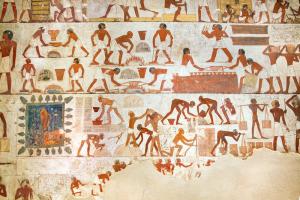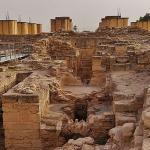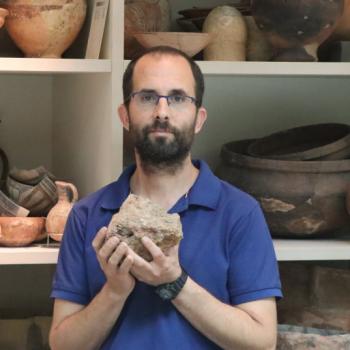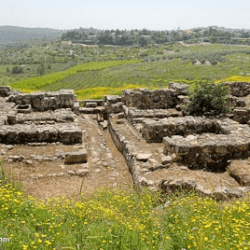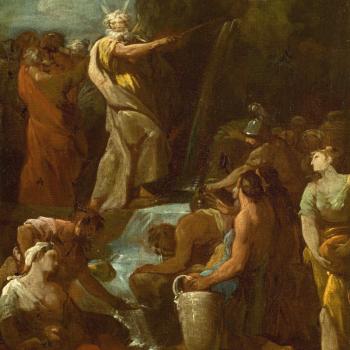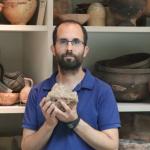Israeli archaeologist Ze’ev Herzog (b. 1941) wrote on 29 October 1999 in Haaretz:
This is what archaeologists have learned . . . the Israelites were never in Egypt, . . . the historic events relating to the stages of the Jewish people’s emergence are radically different from what that story tells. . . . The many Egyptian documents that we have make no mention of the Israelites’ presence in Egypt . . . (1)
Prominent archaeologist James K. Hoffmeier, on the other hand, in his book, Israel in Egypt, published by Oxford University, noted (2),
There is ample documentation during the Middle Kingdom [c. 2055 B.C. – c. 1650 B.C.] of a significant Semitic-speaking population in Egypt. An oft-cited document that provides information on Semites in Egypt during the late Middle Kingdom is Papyrus Brooklyn 35.1446 (3) . . . This document, probably of Theban origin and dating to the late Twelfth [1991-1802 B.C.] or early Thirteenth Dynasty [1802-1649 B.C.], contains a ledger with the names of servants of an Egyptian estate. Over forty . . . bear names of Northwest Semitic type indicating their Syro-Palestinian ethnicity. (4) Since over forty Semites were attached to this single estate in the Thebaid, the number across Egypt, especially in the Delta, was likely considerable. . . . Hayes suggests that there was “a brisk trade in Asiatic slaves carried on by the Asiatics themselves, with Egypt” (5) not unlike that reported in Genesis 37:28, 36.
Recently, a historical inscription of Amenemhet II (1901-1866 B.C.) has come to light which reports on campaigns into the Levant that resulted in the capture of 1,554 prisoners of war. (6) . . . The same text also reinforces what has been known earlier: that Asiatics entered Egypt on commercial ventures. (7) There was commercial contact between Egypt and Canaan as far back as the close of the predynastic and Archaic period (Dynasties 1 and 2) [c. 3100 B.C.–c. 2900 B.C. and c. 2890 B.C.–c. 2686 B.C.] (8) During the Old Kingdom (ca. 2700-2190 B.C.) commercial contacts between Egypt and the Levant flourished, with Egyptians desiring timber from Lebanon. (9)
Hoffmeier continues (10),
Other papyri — such as Papyrus London UC XL.1 and the Papyri Berol 10002, 10004, 10021, 10034, 10047, 10050, 10055, 10066, 10111, 10228, and 10323 — point to a significant number of Asiatics . . . While these remain largely unpublished, Ulrich Luft has begun a thorough investigation of these sources. Some of the professions associated with these Asiatics are singers, dancers, temple workers and doorkeepers, couriers, corvee laborers, and mining-expedition workers. (11)
Egypt was frequented by the peoples of the Levant, especially as a result of climatic problems that resulted in drought . . . from the end of the Old Kingdom (ca. 2190 B.C.) through the Second Intermediate Period (ca. 1786-1550 B.C.). Even during the Empire Period, there are records of hunger and thirst driving people from Canaan and Sinai to Egypt for relief. (12)
We know that there was a period of drought and famine in Canaan during the times of Abraham (b. c. 1880-1860 B.C.) (13), Jacob (b. c. 1775 B.C.), and Joseph (b. c. 1737-1717 B.C.):
Genesis 12:10 (RSV) Now there was a famine in the land. So Abram went down to Egypt to sojourn there, for the famine was severe in the land. (cf. 26:1)
Genesis 42:1-3, 5 When Jacob learned that there was grain in Egypt, he said to his sons, “Why do you look at one another?” And he said, “Behold, I have heard that there is grain in Egypt; go down and buy grain for us there, that we may live, and not die.” So ten of Joseph’s brothers went down to buy grain in Egypt. . . . Thus the sons of Israel came to buy among the others who came, for the famine was in the land of Canaan. (cf. 43:1)
Exodus 12:40 The time that the people of Israel dwelt in Egypt was four hundred and thirty years.
The latter passage offers a tantalizing clue regarding dates. Using Kitchen’s estimate of an Exodus occurring in 1260-1250 B.C. or so, going back 430 years takes us to 1690-1680 B.C. If we date Israel’s time in Egypt from Jacob, this would mean he was about 85-95 years old, upon arriving in Egypt, by Kitchen’s reckoning of his birthdate, which is a rough estimate, but based on lots of chronological data. In a broad sense, the archaeology and the Bible line up fairly well, in terms of Jacob and Israel’s 430-year sojourn in Egypt. We simply can’t achieve certainty in the matter of the life-dates of the patriarchs; but we can have a good general idea.
Egypt had plenty of food during these times (Gen. 12:10; 41:57; 42:1–2; 47:12), but eventually famine came to Egypt as well (Gen. 47:13, 20). The archaeologically and climatologically determined dates above are consistent with the life dates of these patriarchs. The Bible describes how Jacob and a great many Hebrews went to Egypt (Gen. 46:1-27), and were “fruitful and multiplied exceedingly” (47:27) and “the land was filled with them” (Exod. 1:7). This alarmed the Egyptians, so the Hebrews were eventually enslaved (Exod. 1:8-14). That’s the biblical account of how the Hebrews came to be numerous in Egypt, and how they were enslaved. But we can find at least some corresponding information from the Egyptians, too:
Biblical scholars have long been familiar with the scene of laborers at work making bricks from the tomb of Rekhmire, the vizier of Thutmose III (ca. 1479-1425 B.C. . . . ). The adjoining text indicates that these workers were taken as prisoners of war . . . from the king’s campaigns in the south lands (i.e., Nubia) and north lands (i.e., Syria-Canaan). Taking prisoners of war from western Asia during the Empire period is well attested in private and royal monuments. (14)
In short, during nearly twenty years of recorded annals, which are by no means complete, thousands of people from Canaan and Syria were transported to Egypt as prisoners of war or as gifts from various kings. (15)
Amenhotep II’s year 7 Memphis stela [he reigned from 1427 to 1401 or 1397] records 2,255 captured individuals from military campaigns in the Levant. (16). Numbers of prisoners of war from his second campaign are much higher: 101,128, but not as high as the usual exaggerated Egyptian rhetoric which described capturing “hundreds of thousands” or “myriads.” In any event, a lot of Canaanites and other Semites arrived in Egypt involuntarily, and historians don’t deny the historicity of these campaigns. Hoffmeier, accordingly, concludes (17),
From the early part of the eighteenth Dynasty until the accession of Ramesses II (when many date the Exodus), Egypt was teeming with Semitic-speaking peoples. The presence of Israelites in this mix during the New Kingdom, then, is very plausible. . . . it is clear that once the policy of employing prisoners of war in labor projects was introduced, the Israelites and other Semites already living in Egypt were treated likewise. The biblical writer hints that he was aware of other people who shared in the arduous labor regimen. When describing the departure from Egypt, Exodus 12:38 notes: “A mixed multitude . . . also went up with them,” [RSV] which is understood to refer to other enslaved workers who joined the Israelites in their flight from Egypt. (18)
Numbers 11:4, using a different Hebrew word, states that “the rabble that was among them had a strong craving . . .” Nehemiah uses the same Hebrew word as Exodus 12:38 for non-Israelites: “When the people heard the law, they separated from Israel all those of foreign descent.” It no doubt included Egyptians who had married Israelites (as in Lev. 24:10). Deuteronomy 29:11 refers to “the sojourner who is in your camp”: while the Israelites were still wandering in the wilderness. And others who left with the Israelites might have been some of those “who feared the word of the Lord among the servants of Pharaoh” (Exod. 9:20).
Hoffmeier asks:
What became of the tens of thousands of Semites when brought to Egypt from western Asia? . . . During the Amarna period [c. 1360–1332 B.C.], men from the Levant appear in reliefs from Akhenaten’s [r. c. 1353-c. 1334 B.C.] Theban temples as a part of the police force.
The Rekhmire scene reflects the plight of the majority of deportees . . . scooping water, mixing the water and soil to make mud, forming the bricks, and carrying dried bricks to the place where they were to be used. . . .
Relevant to the Exodus narratives, this scene demonstrates that prisoners of war beginning in the Eighteenth Dynasty [c. 1550 B.C.–1292 B.C.] were engaged in brick-making work. Second, Semitic-speaking peoples were employed in connection with building projects for the state. Third, stick-wielding Egyptian “overseers” are shown ready to strike slothful workers. (19)
From Exodus 1:14, we learn that the Israelites were compelled to do “all kinds of work in the field.” New Kingdom tomb paintings show foreigners engaged in agricultural activities. In a study of such scenes from Theban and additional Upper Egyptian tombs, Ellen Morris has shown that Semites were doing this sort of work in the mid-Eighteenth Dynasty, and that the beginning of the reign of Thutmose III, when we know of many prisoners of war from the Levant, was precisely the period when Semitic farm workers appear in Egyptian scenes, doing work (besides making bricks) such as fowling, vine tending, and pressing grapes. (20)
FOOTNOTES
1) Ze’ev Herzog, “Deconstructing the walls of Jericho,” Haaretz, October 29, 1999. http://websites.umich.edu/~proflame/neh/arch.htm.
2) James K. Hoffmeier, Israel in Egypt: The Evidence for the Authenticity of the Exodus Tradition (Oxford University Press, 1996), 61.
3) William C. Hayes, A Papyrus of the Late Middle Kingdom in the Brooklyn Museum [Papyrus Brooklyn 35.1446] (New York: The Brooklyn Museum, 1955). The seven foot long papyrus has been dated to 1809-1743 B.C.
4) Ibid., 92-99. For a thorough discussion of Semitic names in this document, see William F. Albright, “Northwest-Semitic Names in a List of Egyptian Slaves from the Eighteenth Century B.C.,” Journal of the American Oriental Society 74 (1954) 222-233.
5) Hayes, 99.
6) Jaromir Malek and Stephen Quirke, “Memphis, 1991: Epigraphy,” Journal of Egyptian Archaeology 78 (1992) 14, I. 16.
7) Ibid., 14.
8) Michael Hoffman, Egypt Before the Pharaohs (London: ARK paperbacks, 1980), 176, 189, 197, 201-204, 338-339; W. B. Emery, Archaic Egypt (Baltimore: Penguin Books, 1961) 204-205; Amihai Mazar, Archaeology of the Land of the Bible, 10,000-586 B.C.E. (New York: Doubleday, 1990), 106-107; Hoffmeier (ibid.) lists five more related articles in his footnote 84 on page 73.
9) Donald B. Redford, Egypt, Canaan, and Israel in Ancient Times (Princeton University Press, 1992), chap. 2; Barry Kemp, Ancient Egypt: A Social History, ed. B. G. Trigger et al. (Cambridge University Press, 1983), 137-149.
10) Hoffmeier, 62.
11) Ulrich Luft, “Asiatics at Lahun: A Preliminary Report,” in Sesto Congresso Internazionale di Egittologia Atti, vol. 2, ed. S. Curto et al. (Turin: 1992), 291-297.
12) Hoffmeier, 68.
13) I have adopted dates for the patriarchs derived from the scholarly conclusions of Egyptologist and archaeologist Kenneth Kitchen.
14) Hoffmeier, 112.
15) Ibid., 113.
16) For a translation of this stela, see Barbara Cumming, Egyptian Historical Records of the Later Eighteenth Dynasty, fasc. 1 (Warminster: Aris and Phillips, 1982.
17) Hoffmeier, 114.
18) See Martin Noth, Exodus (Philadelphia: Westminster Press, 1962), 99; Philip Hyatt, Exodus (London: Marshall, Morgan, and Scott, 1971), 139; Nahum Sarna, Exploring Exodus (New York: Shocken, 1986), 94-95.
19) Hoffmeier, 114.
20) Ellen Morris, “The Consequences of Conquest: A Foreign Population’s Entrance and Acculturation into Ancient Egyptian Society,” presented at the Society of Biblical Literature annual meeting in New Orleans on November 26, 1996. Hoffmeier (see p. 129, footnote 75) obtained a pre-publication version.
***
Practical Matters: Perhaps some of my 4,200+ free online articles (the most comprehensive “one-stop” Catholic apologetics site) or fifty-one books have helped you (by God’s grace) to decide to become Catholic or to return to the Church, or better understand some doctrines and why we believe them.
Or you may believe my work is worthy to support for the purpose of apologetics and evangelism in general. If so, please seriously consider a much-needed financial contribution. I’m always in need of more funds: especially monthly support. “The laborer is worthy of his wages” (1 Tim 5:18, NKJV). 1 December 2021 was my 20th anniversary as a full-time Catholic apologist, and February 2022 marked the 25th anniversary of my blog.
PayPal donations are the easiest: just send to my email address: apologistdave@gmail.com. You’ll see the term “Catholic Used Book Service”, which is my old side-business. To learn about the different methods of contributing, including 100% tax deduction, etc., see my page: About Catholic Apologist Dave Armstrong / Donation Information. Thanks a million from the bottom of my heart!
***
Photo credit: kairoinfo4u (11-12-16), The tomb-chapel of Rekhmire TT100. The manufacture and transport of mud-bricks are shown, and the slaves are “The captives that His Majesty has bought back to work in the temple of Amun.” The accompanying inscription says the workmen are prisoners of war from Nubia and Syro-Palestine, identified by their black and yellow skin color respectively. Their task is explained: “Making bricks to rebuild nine workshops of Amun in Karnak.” [Flickr / CC-BY-NC-SA 2.0 license]
***
Summary: I present a good deal of archaeological & historical evidence for Hebrews / Semites in Egypt, from 750 years before the Exodus; and also show biblical parallels.


